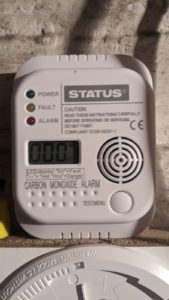This might sound like a silly question with a very obvious answer, but we don’t think so. The sales and customer services teams at Analox have had numerous discussions with customers from around the world who initially thought an oxygen (O2) or even a carbon monoxide (CO) monitor would be suitable for their carbon dioxide (CO2) monitoring application.
Luckily we were on the other end of those discussions and made sure that those customers went away with a monitor that was perfect for their gas safety or gas analysis needs.
In this blog, we hope that you will understand the primary uses of a carbon dioxide monitor, the ins and outs of carbon dioxide, the difference between carbon dioxide and carbon monoxide and finally, understand why using a carbon dioxide detector for monitoring oxygen levels is extremely dangerous!
What do carbon dioxide detectors detect?
To put it bluntly, carbon dioxide detectors detect carbon dioxide, that’s it. It does not detect or monitor any other gas.
The reason why this question needs to be answered is because we have found some people are using the wrong type of detector to detect certain gasses, this could cause harm to people working in those environments.
Recently, an Analox employee discovered a carbon monoxide monitor being used to detect carbon dioxide! This is extremely dangerous. Thankfully this was spotted and they were alerted to the issue!

Why is carbon dioxide detection so important?
Carbon dioxide is a toxic gas which cannot be detected by human senses, you can’t smell it, see it or even taste it. Carbon dioxide can build up in an area or room without people knowing – until it is too late!
When carbon dioxide leaks from a gas cylinder, the carbon dioxide will be denser than the ambient air and will fall to the bottom of the room. This is why we recommend that if you do have a fixed carbon dioxide monitor in the area, the sensor should be placed at around 12 inches from the floor and placed as close to the gas cylinder’s as possible. This means that the sensor will detect a carbon dioxide leak well before the levels rise to working head height.
Carbon dioxide safety tips!
Carbon dioxide naturally occurs in the ambient atmosphere and makes up 0.04% of the gasses in the air we breathe. However a small increase up to 1% can start to have an effect on the body. If you do not have a carbon dioxide safety detector in areas where carbon dioxide is stored, then please take note of key signs and symptoms of carbon dioxide poisoning, this may save a life:
- Nausea
- Vomiting
- Dizziness
- Headaches
- Rapid breathing and heart rate
- Confusion
- Loss of consciousness
Is CO2 and carbon dioxide the same thing?
Yes they are, CO2 is the chemical formula of carbon dioxide and is generally used as a shorthand to carbon dioxide. (You’ll notice it being used now through the rest of this blog.)
The science: one molecule of carbon dioxide is made up of one carbon atom and two oxygen atoms, hence CO2! Check out the image below to see how these atoms fit together.
How can you tell if you have a CO2 leak?
CO2 cannot be detected by human senses, you cannot smell, taste or see it, the best way that you can check for a leak is by using a carbon dioxide monitor.
CO2 is classified as a ‘substance hazardous to health’ by authorities including the Health and Safety Executive so it is incredibly important to monitor leaks.
Although CO2 is present in the air we breathe in very low concentrations, higher concentrations become harmful to your health and have proven fatal in many circumstances.
There are various monitors available on the market, from portable to fixed using a number of gas sensing techniques including:
NDIR – Non-dispersive Infrared Sensing, this is a gas concentration measurement method that uses the unique absorption wavelength range of select gasses to determine the presence of a target gas, in this case, CO2.
GFC – Gas Filter Correlation, a specialized form of GFC/GFX that has been developed to allow highly specialized and select gas properties to be incorporated into the analyzer. In short, the monitor is “programmed” with the specific properties of CO2 and can monitor exclusively for that gas. This helps filter out unwanted gasses and provide an even more safe and accurate measurement.
If you want to learn more about the different CO2 sensing techniques visit our carbon dioxide detection page where we have more information on this subject.
Are portable and fixed CO2 detectors the same?
At a base level, a portable and a fixed CO2 monitor do the same thing. They both monitor the level of CO2 in ambient air, watching out for any rising levels of CO2 which could be harmful or potentially fatal to those in the area. Both detectors will go into an alarm state, using a sounder or a visual alarm (such as LED’s or a beacon), alerting everyone in the area of a potential carbon dioxide leak.
The main differences come in the specific application of the fixed or portable monitor.
Fixed detectors should be used to monitor a specific area where carbon dioxide is used or stored such as in breweries, pubs and labs. Whereas a portable unit can be worn by people who are visiting or entering areas where CO2 is used or stored as personal protection, such as gas delivery drivers or for people who travel between gas store sites. Making portable units the perfect choice for workers who know they are going to enter an area that stores CO2, but are unsure that the location they are traveling to has fixed CO2 safety monitoring in place.
As mentioned before, both types of monitors will use audible and visual alarms to alert everyone in the area to rising levels of CO2, however the Analox CO2BUDDY, a personal CO2 monitor, also provides a vibrating alarm, perfect if the user is in a very loud environment where ear guards would need to be worn.
Fixed and portable detectors also have their own features, making them more useful for specific CO2 detection applications.
Fixed CO2 monitor features:
- 4-20mA output – help to trigger fans which can then help to ventilate the area of CO2 build up
- Gas shut off valves shut off the gas supply to stop the risk of leakage
- Connection to BMS using a Data Output Module (DOM) (Ax60+ system only) means that you can monitor the level of carbon dioxide from your control room
- Extra visual alarms and beacons – helps to highlight alarms should you be operating in a high noise environment
Portable CO2 monitor features:
- Designed to be worn by people, Analox portable monitors use belt clips and lanyard loops to keep the monitor close by
- Our CO2BUDDY can also be calibrated onsite, with no need to send them back for calibration servicing!
Is a carbon monoxide detector the same as a carbon dioxide detector?
For the importance of gas safety, the answer is a hard NO, a carbon monoxide detector is not the same as a carbon dioxide detector. They are two different gasses and require two different sensors to detect them.
Unfortunately people do get these two gasses confused, it is an easy mistake to make as they sound very similar. But it is important to note that you cannot monitor carbon dioxide with a carbon monoxide detector or vice versa. The sensor will not pick up the elevated carbon dioxide in the air and could result in harm to those working in the area, it could also be fatal.
The only similarity between the gasses is that they are both poisonous and neither can be detected by sight or smell.
More about carbon monoxide
Carbon monoxide is a by-product created during the incomplete combustion of fuels, due to there being insufficient oxygen present.
Symptoms of carbon monoxide poisoning can include:
- Headaches
- Dizziness
- Sickness
- Feeling weak
- Confusion
- Shortness of breath
These symptoms may worsen when you spend more time in the affected room or building.
If I use nitrogen should I use a CO2 detector?
Nitrogen is an inert gas, this means that it does not undergo a chemical reaction with other chemical substances. It is also a light gas, meaning that it can displace the levels of oxygen (O2) within an area or room if there is a leak.
Carbon dioxide monitors should not be used to detect low oxygen levels. If nitrogen is being stored or used, please use an oxygen monitor, such as the Ax60+ oxygen variant, or the O2NE+, which is a stand alone oxygen depletion monitor. These monitors are designed to detect unhealthy levels of oxygen.
However, if you have an area where carbon dioxide and nitrogen are both used or stored (pub cellars, laboratories etc) please always opt to fit a dual gas monitor which has a CO2 and O2 sensor fitted such as the Analox Ax60+, or use a portable monitor such as the Aspida dual CO2 and O2 monitor.
People have used O2 monitors to measure for CO2 leaks in the past – please don’t do this. The toxicity of the CO2 will have dire effects on the human body before levels of O2 drop to a life threatening level.
CO2 Calculator
There is a common misconception that if using carbon dioxide (CO2) in your facility you can stay safe by using an oxygen (O2) monitor.
The team here at Analox want to dispel this myth so we can ensure you and your team stay safe when using and storing CO2.
CO2 is a toxic gas meaning that even at relatively low levels it can have dangerous effects on the human body. In the event of a CO2 leak, the CO2 will begin to displace the O2 in the area, however, O2 sensors typically have alarm levels set at around 19.5% and 18% so by the time the CO2 has displaced enough oxygen to trigger these alarm levels the CO2 levels will be dangerously high.
If using CO2, your safety monitor must be a CO2 monitor, this is critical so you are alerted to any leaks at levels which still give you time to take action to keep everyone safe. This also helps to save you money as leaks can be addressed early and in the current times of CO2 shortages, protecting this precious resource is key to any business.
We’ve made this calculator so you can check the resultant O2 levels when the ambient CO2 level changes.
SLOT Specified level of toxicity (1 - 5% of fatalities) SLOD Significant likelihood of death (50% fatalities)
Remember: You CANNOT use an O2 sensor to measure CO2 levels. CO2 levels become hazardous to life long before the CO2 displaces enough O2 for it to trigger an O2 alarm.
To conclude…
If you are storing or using carbon dioxide, please use a carbon dioxide detector. Analox has a range of portable and fixed carbon dioxide monitors that suit a wide range of safety needs.
If you need assistance or advice on what solution is the best for your gas detection problem please get in touch, one of the sales team will be happy to advise on the best solution for you.

